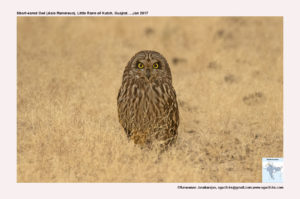
Short-eared Owl Asio flammeus
Etymology:
- Asio : Latin for long-eared owl
- Flammeus : Latin word for Flame coloured
Vernacular Names: Guj: Ravayi dodhuvad, Mal: Puchamunga, Ori: For owls – Pecha, Sinh: Bassa, Mald: Bukhamoonu, Hindi: Chutkanna Ullu, Mar: Chotya Kanache Ghubad
Distribution in India: Wide spread winter visitor and passage migrant in India
Description: Size of 34–42 cm; wt. of male is 206–396 g; wt. of female is 260–475 g; wingspan is 95–110 cm. It is a medium-sized owl with distinctive moth-like flight, wing beats bouncing, high and flapping. The head is large and round, with very small tufts, generally unseen, arising from center of forehead. It has a large round facial disc that is grey-white, with black around eyes, white chin, and facial ruff and forehead is white, brown and buff. The upperparts are mottled brown and buff, resembling dried grasses; wings are long and broad, with pale ocher patch outside carpal region. The central tail-feathers are with brown blotching within buff area between 5–6 dark horizontal bars. The underparts are whitish to pale buff with dense vertical breast streaks, thinning out on sides and flanks. The underwing is with dark wrist markings, otherwise generally buffish-white throughout, with blackish tips. The eyes are yellow; bill is black; thighs and feet are whitish-buff. The female is browner above, more buff below, more heavily streaked, larger. The juvenile has its crown and rump as dark brown, facial disc is brown-black with feathers tipped buff, mantle is with incomplete buff bars, and underparts are warm buff.
Habitat: It is found in tundra, marsh, grassland, savanna, moorlandand montane forest. It is found from sea-level to 4000 m.
Food habits: It eats small mammals like voles , shrews , moles , rabbits and hares , pocket gophers , jumping mice and deer mice , bats ,mustelids and some birds .It is diurnal, crepuscular and nocturnal; activity dictated by prey density and by hunger of adults and nestlings. It hunts low above ground, often quartering with wings held in slight dihedral, or hovering and quickly adjusting flight to drop on to prey. It uses auditory cues to locate prey; observed chasing migrating passerines attracted to artificial lights.Its low wing-loading facilitates slow flight speed, aerial agility, reduced aerodynamic flight noise, ability to hear while in flight, and reduced detection by prey; it also relies on vision.
Breeding habits: They breed in Europe, Asia, North and South America, the Caribbean, Hawaii and the Galápagos Islands. Breeds in Mar–Jun in Northern hemisphere; breeding in Sept in Southern hemisphere. They have a seasonal monogamy. They nest on ground often on slight ridge or mound. The female scrapes out bowl and lines it with grasses and downy feathers. The male performs sky-dancing display with song, aerobatics and wing-clapping. It lays a clutch of 5–10 eggs. The female incubates and broods. It retrieves eggs from outside nest by hooking bill under and rolling them back. The male feeds female, and defends nest with distraction displays and vocalizations. The incubation period is 26–29 days. The chick hatches with eyes closed, egg tooth present, with buffy down. The young leave nest in. 12–18 days but unable to fly, hide in vegetation.